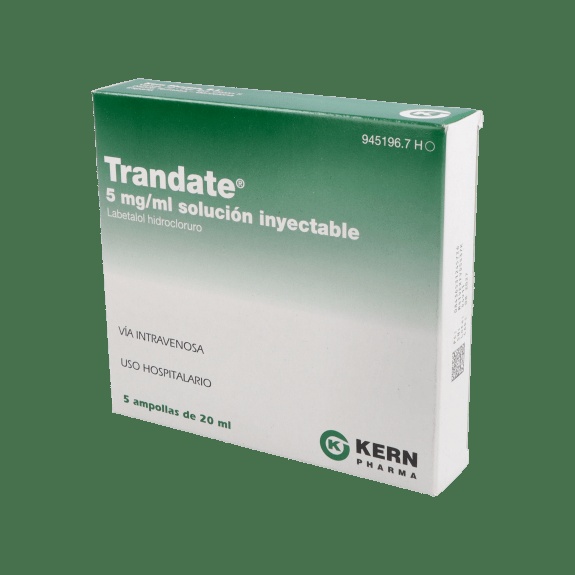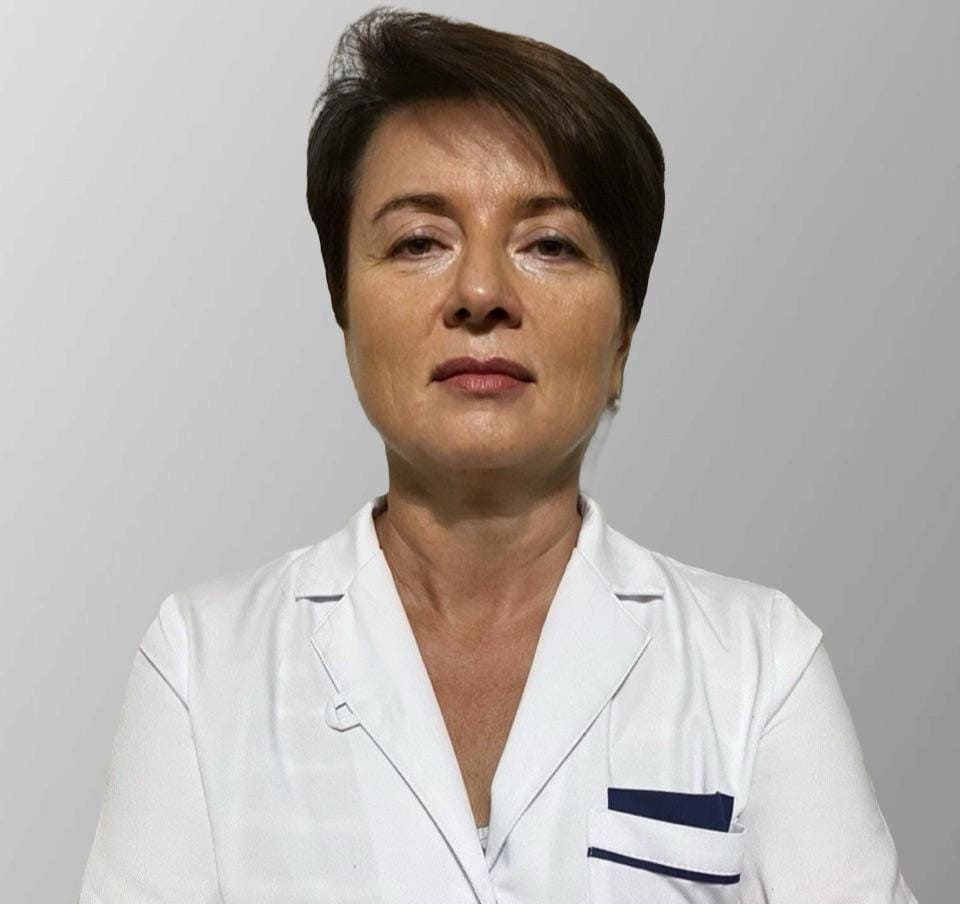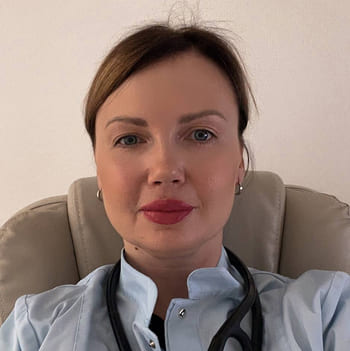

TRANDATE 5 mg/ml SOLUÇÃO INJETÁVEL

Pergunte a um médico sobre a prescrição de TRANDATE 5 mg/ml SOLUÇÃO INJETÁVEL

Como usar TRANDATE 5 mg/ml SOLUÇÃO INJETÁVEL
Introdução
Prospecto: informação para o utilizador
Trandate 5 mg/ml solução injetável
Hidrocloruro de labetalol
Leia todo o prospecto detenidamente antes de começar a usar o medicamento, porque contém informações importantes para si.
- Conserva este prospecto, porque pode ter que voltar a lê-lo.
- Se tiver alguma dúvida, consulte o seu médico, farmacêutico ou enfermeiro.
- Este medicamento foi-lhe prescrito para si e não deve dá-lo a outras pessoas, mesmo que tenham os mesmos sintomas da doença, porque pode prejudicá-las.
- Se experimentar efeitos adversos, consulte o seu médico, farmacêutico ou enfermeiro, mesmo que se trate de efeitos adversos que não aparecem neste prospecto.
Conteúdo do prospecto:
- O que é Trandate e para que é utilizado
- O que precisa saber antes de começar a usar Trandate
- Como usar Trandate
- Possíveis efeitos adversos
- Conservação de Trandate
- Conteúdo do envase e informação adicional
1. O que é Trandate e para que é utilizado
Trandate pertence ao grupo de medicamentos denominados alfa- e beta-bloqueantes.
Trandate está indicado no tratamento de:
- Hipertensão grave (tensão arterial alta), incluindo a do embarazo, quando seja essencial um rápido controlo da pressão sanguínea
- Anestesia, quando está indicada uma técnica hipotensora
- Episódios hipertensivos (tensão arterial alta) após infarto agudo de miocárdio.
Trandate não exerce ação prejudicial sobre a função do rim e é particularmente adequado para ser utilizado em pacientes hipertensos com disfunção do rim.
2. O que precisa saber antes de começar a usar Trandate
Não use Trandate
- Se é alérgico ao hidrocloruro de labetalol, ou a qualquer outro componente de Trandate.
- Se padece bloqueio auriculo-ventricular de segundo e terceiro grau (bloqueio cardíaco).
- Em caso de choque cardiogénico (falha do coração).
- Em caso de hipotensão (tensão arterial baixa) prolongada e grave.
- Se sofre bradicardia (diminuição do ritmo do coração) grave.
- Se padece asma ou obstrução das vias respiratórias.
- Em caso de hipertensão (tensão arterial alta), após infarto agudo de miocárdio, quando existe
vasoconstricção periférica que sugere baixo débito cardíaco.
Advertências e precauções
Deve ter especial cuidado em pacientes com reserva cardíaca escassa (capacidade do coração para funcionar por cima do seu nível normal) e falha cardíaca. Estes casos devem ser controlados com um glucósido cardíaco (medicamento para controlar o ritmo do coração) e um diurético (medicamento para aumentar a eliminação de líquidos) antes de iniciar a terapia com Trandate.
Não é necessário suspender o tratamento com Trandate antes da anestesia, se bem que os pacientes devem receber atropina por via intravenosa antes da indução.
Risco de reação anafiláctica (reação alérgica grave): Os pacientes com antecedentes de reação anafiláctica grave a alguma variedade de alérgenos (substâncias que podem produzir reações alérgicas), que estejam tomando β-bloqueantes (medicamentos para o tratamento da tensão arterial alta) podem ser mais sensíveis ao repetir-se a exposição, bem accidental, de diagnóstico ou terapêutica. Estes pacientes podem não responder às doses habituais de adrenalina que se usam para tratar as reações alérgicas.
Crianças e adolescentes
Não se estabeleceu a segurança e eficácia deste medicamento em crianças.
Interação de Trandate com outros medicamentos
Informa ao seu médico ou farmacêutico se está utilizando, ou tem utilizado recentemente qualquer outro medicamento, mesmo os adquiridos sem receita médica, porque pode ser necessário interromper o tratamento ou ajustar a dose de algum deles.
Deve ter especial cuidado com a administração simultânea com os seguintes medicamentos:
Agentes antiarrítmicos de Classe I ou antagonistas do cálcio do tipo verapamil (medicamentos que se usam para suprimir ou prevenir as alterações do ritmo cardíaco).
Trandate pode potenciar os efeitos hipotensores do halotano.
Gravidez, lactação e fertilidade
Consulte o seu médico ou farmacêutico antes de utilizar qualquer medicamento.
Foram notificados casos de dor e fenómeno de Raynaud nos mamilos (ver seção 4).
Gravidez
Trandate só deve ser usado no primeiro trimestre de gravidez se o potencial benefício superar o potencial risco.
Lactação
Trandate é excretado pelo leite materno, embora não se tenham descrito efeitos adversos em crianças lactentes.
Condução e uso de máquinas
Não se descreveu qualquer efeito sobre a capacidade para conduzir ou utilizar máquinas devido ao uso deste medicamento.
Uso em desportistas
Informa-se os desportistas que este medicamento contém um componente que pode estabelecer um resultado analítico no controlo de dopagem como positivo.
3. Como usar Trandate
Siga exatamente as instruções de administração de Trandate indicadas pelo seu médico. Consulte o seu médico ou farmacêutico se tiver dúvidas.
Se estima que a ação de Trandate é demasiado forte ou débil, comunique-o ao seu médico ou farmacêutico.
Trandate está indicado para utilizar por via intravenosa em pacientes hospitalizados.
Os pacientes devem receber o fármaco estando sempre em posição supina (deitado sobre as costas) ou lateral esquerda (deitado de lado para a esquerda).
Evite levantar o paciente antes de que transcorram 3 horas, porque pode aparecer uma hipotensão postural excessiva.
Adultos
Injeção em bolus
Se é essencial reduzir a pressão sanguínea rapidamente, deve ser administrada uma dose de 50 mg mediante injeção intravenosa durante pelo menos um minuto e repetir, se for necessário, a intervalos de 5 minutos até que se produza uma resposta satisfatória. A dose total não deve exceder 200 mg.
O efeito máximo sucede geralmente dentro dos 5 primeiros minutos e dura cerca de 6 horas, embora possa prolongar-se até 18 horas.
Perfusão intravenosa
Deve ser empregue uma solução de 1 mg/ml. Diluir, por exemplo, o conteúdo de duas ampolas (200 mg) em 200 ml com solução injetável de cloreto de sódio e glicose ou glicose a 5%.
Hipertensão na gravidez
Começar a perfusão com 20 mg/hora, a seguir pode-se duplicar a dose cada 30 minutos até que se obtenha uma resposta satisfatória ou se atinja uma dose de 160 mg/hora. Ocasionalmente podem ser necessárias doses mais altas.
Episódios hipertensivos após infarto agudo de miocárdio
Começar a perfusão com 15 mg/hora e aumentar gradualmente até um máximo de 120 mg/horas, dependendo do controlo da pressão sanguínea.
Hipertensão devida a outras causas
Infundir a uma velocidade de uns 2 mg/min até que se obtenha uma resposta satisfatória, logo detener a perfusão. A dose eficaz é, geralmente, de 50-200 mg, mas podem ser necessárias doses mais grandes, especialmente em pacientes com feocromocitoma. A velocidade de perfusão pode ser ajustada de acordo com a resposta, a critério do médico.
É desejável monitorizar a pressão sanguínea e o ritmo cardíaco após a injeção e durante a perfusão.
Na maioria dos pacientes, há um pequeno descenso no ritmo cardíaco; a bradicardia grave é pouco habitual, mas pode ser controlada inyectando 1-2 mg de atropina intravenosa. Deve-se vigiar a função respiratória, especialmente em pacientes com uma alteração conhecida.
Uma vez que se tenha reduzido adequadamente a pressão sanguínea mediante bolus ou perfusão, deve-se substituir a terapia de manutenção com comprimidos de Trandate, começando com uma dose de 100 mg duas vezes ao dia.
Trandate foi administrado em pacientes com hipertensão não controlada que já vinham recebendo outros agentes hipotensores, incluindo β-bloqueantes, sem efeitos adversos.
Anestesia hipotensora
A indução deve ser feita com agentes estándar, p. ex.: tiopentona sódica e a anestesia deve ser mantida com óxido nitroso e oxigénio com ou sem halotano. A dose inicial recomendada de Trandate é de 10-20 mg intravenosamente, dependendo da idade e estado do paciente. Os pacientes para os quais o halotano está contraindicado requerem, geralmente, uma dose inicial mais alta de Trandate (25-30 mg).
Se, após 5 minutos, não se obtiver uma hipotensão satisfatória, devem ser realizados incrementos de 5-10 mg até que se atinja o nível desejado de pressão sanguínea.
O halotano e o labetalol actuam sinergicamente. Por isso, a concentração de halotano não deve exceder 1-1,5%, porque pode ocorrer um descenso importante da pressão sanguínea.
Após a injeção de Trandate, a pressão sanguínea pode ser ajustada rapidamente e facilmente alterando a concentração de halotano e/ou ajustando a inclinação da mesa. A duração média da hipotensão após 20-25 mg de Trandate é de 50 minutos.
A hipotensão induzida pelo labetalol é facilmente reversível mediante 0,6 mg de atropina e interrompendo o halotano.
Se usa mais Trandate do que devia
Em caso de sobredosagem ou injeção acidental, consulte imediatamente o seu médico ou farmacêutico, ou o Serviço de Informação Toxicológica. Telefone: 91 562 04 20. Recomenda-se levar o envase e o prospecto do medicamento ao profissional de saúde.
São esperados efeitos cardiovasculares profundos, tais como hipotensão postural excessiva (descida da tensão arterial por mudanças súbitas de posição) e, por vezes, bradicardia (descida da frequência cardíaca). Os pacientes devem permanecer deitados em posição supina com as pernas levantadas. Justifica-se o lavado gástrico ou a indução ao vómito dentro das primeiras horas de ingestão; empregar um glucósido cardíaco (medicamento para controlar o ritmo do coração) e um diurético (medicamento para aumentar a eliminação de líquidos) em caso de falha cardíaca; em caso de broncospasmo, administrar um agonista β2 em aerosol (medicamentos para dilatar os brônquios). Devem ser dados de 0,25 a 3 mg de atropina intravenosa para aliviar a bradicardia. Para melhorar a circulação, administrar uma dose inicial de 5 a 10 mcg de noradrenalina intravenosa, preferivelmente à isoprenalina, repetindo-se segundo a resposta.
Alternativamente, pode ser infundida a noradrenalina a uma velocidade de 5 mcg por minuto até que a resposta seja satisfatória.
Em sobredosagem grave, deve ser administrado, preferivelmente, glucagon via intravenosa. Deve ser administrada uma dose inicial de 5 a 10 mg em glicose ou salina, seguida de uma perfusão intravenosa de 5 mg/hora ou o que for necessário para manter o rendimento cardíaco.
Foi descrito fracasso renal oligúrico após sobredosagem maciça de labetalol por via oral. Em um caso, o uso de dopamina para aumentar a pressão sanguínea pode ter agravado o fracasso renal.
A hemodiálise elimina menos de 1% do cloridrato de labetalol da circulação.
Se tiver alguma outra dúvida sobre o uso deste produto, pergunte ao seu médico ou farmacêutico.
4. Possíveis efeitos adversos
Como todos os medicamentos, Trandate pode ter efeitos adversos, embora nem todas as pessoas os sofram.
Trandate é geralmente bem tolerado. Pode produzir-se hipotensão postural se se permitir que os pacientes se coloquem em posição vertical antes de que transcorram 3 horas da administração.
Entre os casos raros de hipersensibilidade, foram descritos: erupção, prurido, angioedema e dispnéia.
Também foram notificados alguns casos de congestão nasal.
Foram notificados casos raros de elevação das provas funcionais hepáticas, icterícia (coloração amarelenta da pele, tanto hepatocelular como colestásica) e hepatite (inflamação do fígado) e necrose hepática (morte do tecido do fígado). Estes sinais e sintomas são reversíveis, geralmente, ao suspender o tratamento.
Foram descritos alguns casos de bradicardia e de bloqueio cardíaco.
Com frequência não conhecida (não pode ser estimada a partir dos dados disponíveis), foi descrito dor nos mamilos: diminuição intermitente do fluxo de sangue para os mamilos, o que pode provocar entorpecimento, palidez e dor nos mamilos (fenómeno de Raynaud).
Se considera que algum dos efeitos adversos que sofre é grave ou se apercebe de qualquer efeito adverso não mencionado neste prospecto, informe o seu médico ou farmacêutico.
5. Conservação de Trandate
Mantenha este medicamento fora da vista e do alcance das crianças.
Conservar no embalagem original para protegê-lo da luz.
Não utilize Trandate após a data de caducidade indicada no envase após CAD. A data de caducidade é o último dia do mês que se indica.
Os medicamentos não devem ser jogados fora pelos esgotos nem para o lixo. Deposite os envases e os medicamentos que não precisa no Ponto SIGRE da farmácia. Em caso de dúvida, pergunte ao seu farmacêutico como se livrar dos envases e dos medicamentos que não precisa. Desta forma, ajudará a proteger o meio ambiente.
6. Conteúdo do envase e informação adicional
Composição de Trandate
- O princípio ativo é hidrocloruro de labetalol. Cada ampola de 20 ml contém 100 mg de hidrocloruro de labetalol.
- Os demais componentes (excipientes) são: hidróxido de sódio, ácido clorídrico e água para preparações injetáveis.
Aspecto do produto e conteúdo do envase
Envases com 5 ampolas de vidro transparente de 20 ml com 100 mg de hidrocloruro de labetalol.
Outras apresentações
Trandate 100 mg comprimidos: Envase com 30 comprimidos.
Trandate 200 mg comprimidos: Envase com 30 comprimidos.
Titular da autorização de comercialização e responsável pela fabricação
Kern Pharma, S.L.
Polígono Ind. Colón II
Vênus, 72
08228 Terrassa (Barcelona)
Este prospecto foi aprovado em Dezembro de 2021.
A informação detalhada e atualizada deste medicamento está disponível na página web da Agência Española de Medicamentos y Productos Sanitarios (AEMPS) http://www.aemps.es/.
-------------------------------------------------------------------------------------------------------------------
Esta informação está destinada unicamente a médicos ou profissionais do sector sanitário:
Trandate é compatível com os seguintes fluidos intravenosos:
- Glicose 5%
- Cloreto de sódio a 0,18% em glicose a 4%
- Cloreto potássico a 0,3% em glicose a 5%
- Solução de lactato de sódio composto.
Descartar as misturas não utilizadas às 24 horas da sua preparação.
Trandate é incompatível com solução injetável de bicarbonato de sódio a 4,2% p/v.
- País de registo
- Substância ativa
- Requer receita médicaSim
- Fabricante
- Esta informação é apenas para referência e não constitui aconselhamento médico. Consulte sempre um médico antes de tomar qualquer medicamento. A Oladoctor não se responsabiliza por decisões médicas baseadas neste conteúdo.
- Alternativas a TRANDATE 5 mg/ml SOLUÇÃO INJETÁVELForma farmacêutica: INJETÁVEL, 5 mg/mlSubstância ativa: labetalolFabricante: S.A.L.F. S.P.A. Laboratorio FarmacologicoRequer receita médicaForma farmacêutica: COMPRIMIDO, 100 mgSubstância ativa: labetalolFabricante: Kern Pharma S.L.Requer receita médicaForma farmacêutica: COMPRIMIDO, 200 mgSubstância ativa: labetalolFabricante: Kern Pharma S.L.Requer receita médica
Médicos online para TRANDATE 5 mg/ml SOLUÇÃO INJETÁVEL
Avaliação de posologia, efeitos secundários, interações, contraindicações e renovação da receita de TRANDATE 5 mg/ml SOLUÇÃO INJETÁVEL – sujeita a avaliação médica e regras locais.










